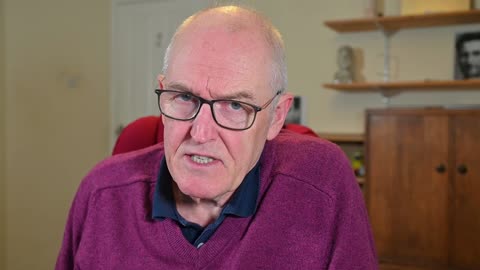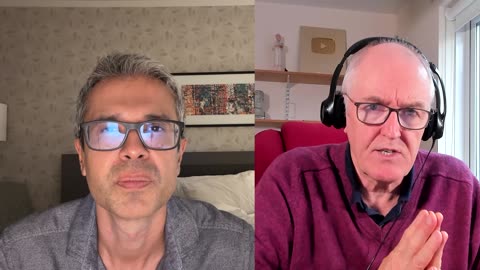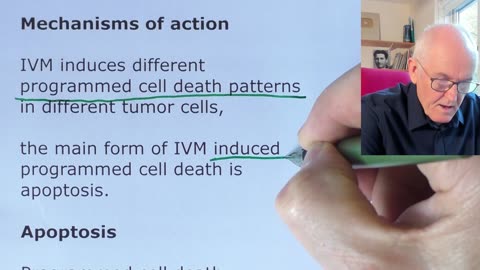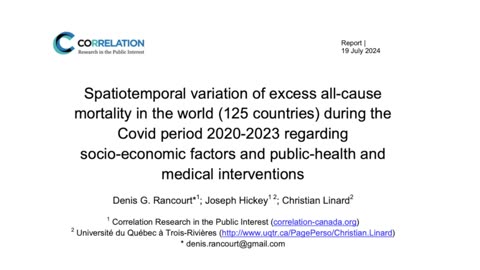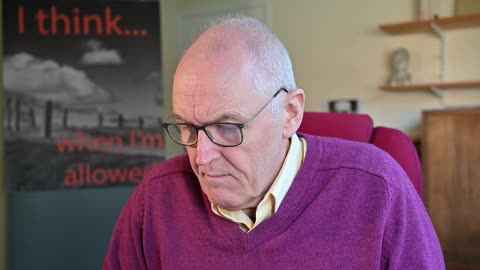
-
Fen ben for cancer ?
 Dr. John CampbellFenbendazole Enhancing Anti-Tumor Effect: A Case Series (2021) https://www.scitechnol.com/peer-review/fenbendazole-enhancing-antitumor-effect-a-case-series-2Kms.php?article_id=14307&fbclid=IwAR0tYpTZb4fp2_AO8e_WGWM5mcqv-RNfI-5SID9OWDcRiwHyHmQBKsjeSKk Full PDF with radiology https://www.scitechnol.com/peer-review/fenbendazole-enhancing-antitumor-effect-a-case-series-P3SV.pdf Background Fenbendazole (FBZ) is a cheap and readily available anti-parasitic commonly used in veterinary medicine. FBZ belongs to the benzimidazole drug class which destabilize microtubules through a mechanism similar to the anti-oncogenic vinca alkaloids. Although there are no reported cases in the literature, there have been several anecdotal stories published on website blogs with individuals praising its ability to treat a wide variety of cancers. Case Presentations Three patients with various genitourinary malignancies, who demonstrated complete response after receiving FBZ therapy, as a single or supplementary chemotherapeutic agent. In two patient scenarios, they had experienced progression of metastatic disease despite multiple lines of therapy prior to initiation of FBZ. No side effects from FBZ were reported. Conclusion FBZ appears to be a potentially safe and effective antineoplastic agent, that can be repurposed for human use in treating genitourinary malignancies. Further research is necessary to define the role of FBZ as a chemotherapeutic option. Details FBZ is a cheap anti-helminthic medication commonly used in veterinary practice, However, despite multiple anecdotal stories and news outlet reports for its efficacy in treating metastatic cancer, the clinical literature behind utilizing FBZ as a potential anti-neoplastic agent remains nonexistent. Case 1 A 63-year-old Caucasian male presented with flank pain, rapid weight loss, and transient fever. Abdominal Computed Topography (CT) revealed a 3 cm left solid renal mass. Renal Cell Carcinoma (RCC) Traditional drugs used then discontinued One month after discontinuation, repeat MRI showed increase in size of recurrent left renal mass, pancreatic head and body lesion He also started alternative therapy with FBZ 1 gm three times per week at the suggestion of one of his friends with head/neck cancer. Interval MRI imaging found near complete resolution of the previously noted left renal mass, as well as decrease in pancreatic head/body and pelvic bone lesion Serial imaging for the past 10 months have not shown any evidence of recurrence or metastatic disease. He has continued taking FBZ without any reported side effects. Case 2 A 72-year-old caucasian male Urethral lesion Distal penectomy Pathology showing high-grade urothelial carcinoma of the urethra Four years later, the patient developed a cough, 5.5 cm × 4.0 cm left hilar mass and a left upper lobe nodule, with multiple abnormal lymph nodes Bronchoscopy with biopsy revealed squamous carcinoma, (probable primary) Chemotherapy given Developed progressive retroperitoneal disease The patient opted for complementary therapy with FBZ 1 gram orally three days per week, vitamin E 800 mg daily, curcumin 600 mg daily, and CBD oil Serial CTs from the past 9 months showed progressive decrease in size to 0.5 cm × 0.5 cm, complete radiographic response. Case 3 A 63-year-old Caucasian female CT imaging revealed a 7.5 cm right lateral bladder mass with extensions Hydronephrosis requiring percutaneous nephrostomy. Transurethral Resection of Bladder Tumor (TURBT) demonstrated a large necrotic mass, pathology confirming urothelial carcinoma with 85% squamous and 2% sarcomatoid histology. 6 cycles over the course of 4 months, along with concurrent FBZ 1 gram three times weekly. Follow-up CT revealed no evidence of disease with minimal residual thickening in the right inferior bladder wall She declined to proceed with cystectomy and remains on surveillance with no evidence of progression. Discussion We have three patients with different primary genitourinary tumors who demonstrated complete response after receiving FBZ therapy. This raises the question of how effective FBZ can be as an anti-oncogenic agent and merits further investigation. FBZ belongs to a class of microtubule-destabilizing agents The ability to disrupt microtubule polymerization,to induce mitotic arrest, and promote apoptosis. ? p53 activation The variety of mechanisms by which this class of medications functions may help limit the propagation of resistant cancer cell lines FBZ has been safely utilized as an anti-parasitic for various different animal species and could be repurposed for treating human malignancies. Several benzimidazoles have already shown promise for human repurposing. Mebendazole has been shown in case reports to be efficacious with few side effects in patients with metastatic adrenocortical carcinoma and metastatic colon cancer Mebendazole, effective in animal studies for glioblastoma Flubendazole, animal studies, hematologic malignancies Given evidence of high tolerability and applicability to a wide range of malignancies, this warrants further investigation for FBZ and other benzimidazoles as safe chemotherapeutic options. Conclusion There remains limited data with few published studies on the anti-oncogenic properties of FBZ. Other benzimidazoles have been studied to a larger extent, and the knowledge can be drawn upon to help guide future FBZ studies, and to gauge the efficacy of this drug class whether as a solitary agent or in combination therapy. Given the potential benefits of FBZ with what seems to be a limited toxicity profile, further research is warranted to evaluate the clinical settings in which this medication may be beneficial and repurposed, for patients with progressive genitourinary malignancy and possibly in other malignant settings as well.34.9K views 260 comments
Dr. John CampbellFenbendazole Enhancing Anti-Tumor Effect: A Case Series (2021) https://www.scitechnol.com/peer-review/fenbendazole-enhancing-antitumor-effect-a-case-series-2Kms.php?article_id=14307&fbclid=IwAR0tYpTZb4fp2_AO8e_WGWM5mcqv-RNfI-5SID9OWDcRiwHyHmQBKsjeSKk Full PDF with radiology https://www.scitechnol.com/peer-review/fenbendazole-enhancing-antitumor-effect-a-case-series-P3SV.pdf Background Fenbendazole (FBZ) is a cheap and readily available anti-parasitic commonly used in veterinary medicine. FBZ belongs to the benzimidazole drug class which destabilize microtubules through a mechanism similar to the anti-oncogenic vinca alkaloids. Although there are no reported cases in the literature, there have been several anecdotal stories published on website blogs with individuals praising its ability to treat a wide variety of cancers. Case Presentations Three patients with various genitourinary malignancies, who demonstrated complete response after receiving FBZ therapy, as a single or supplementary chemotherapeutic agent. In two patient scenarios, they had experienced progression of metastatic disease despite multiple lines of therapy prior to initiation of FBZ. No side effects from FBZ were reported. Conclusion FBZ appears to be a potentially safe and effective antineoplastic agent, that can be repurposed for human use in treating genitourinary malignancies. Further research is necessary to define the role of FBZ as a chemotherapeutic option. Details FBZ is a cheap anti-helminthic medication commonly used in veterinary practice, However, despite multiple anecdotal stories and news outlet reports for its efficacy in treating metastatic cancer, the clinical literature behind utilizing FBZ as a potential anti-neoplastic agent remains nonexistent. Case 1 A 63-year-old Caucasian male presented with flank pain, rapid weight loss, and transient fever. Abdominal Computed Topography (CT) revealed a 3 cm left solid renal mass. Renal Cell Carcinoma (RCC) Traditional drugs used then discontinued One month after discontinuation, repeat MRI showed increase in size of recurrent left renal mass, pancreatic head and body lesion He also started alternative therapy with FBZ 1 gm three times per week at the suggestion of one of his friends with head/neck cancer. Interval MRI imaging found near complete resolution of the previously noted left renal mass, as well as decrease in pancreatic head/body and pelvic bone lesion Serial imaging for the past 10 months have not shown any evidence of recurrence or metastatic disease. He has continued taking FBZ without any reported side effects. Case 2 A 72-year-old caucasian male Urethral lesion Distal penectomy Pathology showing high-grade urothelial carcinoma of the urethra Four years later, the patient developed a cough, 5.5 cm × 4.0 cm left hilar mass and a left upper lobe nodule, with multiple abnormal lymph nodes Bronchoscopy with biopsy revealed squamous carcinoma, (probable primary) Chemotherapy given Developed progressive retroperitoneal disease The patient opted for complementary therapy with FBZ 1 gram orally three days per week, vitamin E 800 mg daily, curcumin 600 mg daily, and CBD oil Serial CTs from the past 9 months showed progressive decrease in size to 0.5 cm × 0.5 cm, complete radiographic response. Case 3 A 63-year-old Caucasian female CT imaging revealed a 7.5 cm right lateral bladder mass with extensions Hydronephrosis requiring percutaneous nephrostomy. Transurethral Resection of Bladder Tumor (TURBT) demonstrated a large necrotic mass, pathology confirming urothelial carcinoma with 85% squamous and 2% sarcomatoid histology. 6 cycles over the course of 4 months, along with concurrent FBZ 1 gram three times weekly. Follow-up CT revealed no evidence of disease with minimal residual thickening in the right inferior bladder wall She declined to proceed with cystectomy and remains on surveillance with no evidence of progression. Discussion We have three patients with different primary genitourinary tumors who demonstrated complete response after receiving FBZ therapy. This raises the question of how effective FBZ can be as an anti-oncogenic agent and merits further investigation. FBZ belongs to a class of microtubule-destabilizing agents The ability to disrupt microtubule polymerization,to induce mitotic arrest, and promote apoptosis. ? p53 activation The variety of mechanisms by which this class of medications functions may help limit the propagation of resistant cancer cell lines FBZ has been safely utilized as an anti-parasitic for various different animal species and could be repurposed for treating human malignancies. Several benzimidazoles have already shown promise for human repurposing. Mebendazole has been shown in case reports to be efficacious with few side effects in patients with metastatic adrenocortical carcinoma and metastatic colon cancer Mebendazole, effective in animal studies for glioblastoma Flubendazole, animal studies, hematologic malignancies Given evidence of high tolerability and applicability to a wide range of malignancies, this warrants further investigation for FBZ and other benzimidazoles as safe chemotherapeutic options. Conclusion There remains limited data with few published studies on the anti-oncogenic properties of FBZ. Other benzimidazoles have been studied to a larger extent, and the knowledge can be drawn upon to help guide future FBZ studies, and to gauge the efficacy of this drug class whether as a solitary agent or in combination therapy. Given the potential benefits of FBZ with what seems to be a limited toxicity profile, further research is warranted to evaluate the clinical settings in which this medication may be beneficial and repurposed, for patients with progressive genitourinary malignancy and possibly in other malignant settings as well.34.9K views 260 comments -
New vitamin D paper
 Dr. John CampbellVitamin D: A key player in COVID‐19 immunity and lessons from the pandemic to combat immune‐evasive variants https://link.springer.com/article/10.1007/s10787-024-01578-w As of July 2024 775,754,322 confirmed cases of COVID-19 13,578,710,228 vaccine doses had been administered It is unclear why some patients develop severe symptoms while others do not, literature suggests a role for vitamin D. Vitamin D plays a crucial role in the infection or in ameliorating the severity of symptoms. VDD is associated with increased hospitalization of severely ill patients and increased levels of COVID-19-caused mortality. The mechanism of action of vitamin D and vitamin D deficiency (VDD) is well understood. Vitamin D levels and genetic variations in the vitamin D receptor (VDR) gene significantly impact the severity and out- comes of COVID-19, especially in the infections caused by Delta and Omicron variants. Furthermore, VDD causes immune system dysregulation upon infection with SARS-CoV-2, indicating that vitamin D sufficiency is crucial in fighting against COVID-19 infection. Potential role as a prophylactic and treatment adjunct. Immunomodulatory and anti-inflammatory effects of vitamin D Ability to enhance the efficacy of new antiviral drugs Large- scale randomized trials are required to reach a definitive conclusion. Mechanisms of action Macrophages activated to produce defensive proteins and stimulate naïve T cells Activate T lymphocytes and mature B lymphocytes into plasma cells Prevents inflammation, vasoconstriction, and fibrosis of the lungs. Prevents excess release of cytokines from macrophages Prevents excessive CRP production in the liver Vit D can reduce viral replication Vitamin D can protect against ARDS, the main death-causing complication of COVID-19 Seven out of nine studies reviewed by Yisak https://pubmed.ncbi.nlm.nih.gov/33447107/ have indicated a crucial role in vitamin D status in COVID-19 infection, prognosis, and mortality. Vitamin D dose To decrease the risk of contracting a new infection, people at high risk of COVID-19 to take 10,000 IU d−1 of vitamin D for a few weeks, followed by 5000 IU d−1 to raise the concentrations of the active form of vitamin D. Blood levels Levels below 12 ng/mL indicate severe deficiency. Levels between 12 and 20 ng/mL suggest deficiency Treatment recommended for levels below 30 ng/mL Optimal levels are 30–60 ng/mL, Recommended prophylactic dose 0–1 years, 400 IU/day (10 mcg) > 1 year, 600 IU (15 mcg) > 8 years, half an adult dose Adults, 800– 2000 IU of cholecalciferol Routine toxicity monitoring is unnecessary for doses under 10,000 IU/day24.2K views 297 comments
Dr. John CampbellVitamin D: A key player in COVID‐19 immunity and lessons from the pandemic to combat immune‐evasive variants https://link.springer.com/article/10.1007/s10787-024-01578-w As of July 2024 775,754,322 confirmed cases of COVID-19 13,578,710,228 vaccine doses had been administered It is unclear why some patients develop severe symptoms while others do not, literature suggests a role for vitamin D. Vitamin D plays a crucial role in the infection or in ameliorating the severity of symptoms. VDD is associated with increased hospitalization of severely ill patients and increased levels of COVID-19-caused mortality. The mechanism of action of vitamin D and vitamin D deficiency (VDD) is well understood. Vitamin D levels and genetic variations in the vitamin D receptor (VDR) gene significantly impact the severity and out- comes of COVID-19, especially in the infections caused by Delta and Omicron variants. Furthermore, VDD causes immune system dysregulation upon infection with SARS-CoV-2, indicating that vitamin D sufficiency is crucial in fighting against COVID-19 infection. Potential role as a prophylactic and treatment adjunct. Immunomodulatory and anti-inflammatory effects of vitamin D Ability to enhance the efficacy of new antiviral drugs Large- scale randomized trials are required to reach a definitive conclusion. Mechanisms of action Macrophages activated to produce defensive proteins and stimulate naïve T cells Activate T lymphocytes and mature B lymphocytes into plasma cells Prevents inflammation, vasoconstriction, and fibrosis of the lungs. Prevents excess release of cytokines from macrophages Prevents excessive CRP production in the liver Vit D can reduce viral replication Vitamin D can protect against ARDS, the main death-causing complication of COVID-19 Seven out of nine studies reviewed by Yisak https://pubmed.ncbi.nlm.nih.gov/33447107/ have indicated a crucial role in vitamin D status in COVID-19 infection, prognosis, and mortality. Vitamin D dose To decrease the risk of contracting a new infection, people at high risk of COVID-19 to take 10,000 IU d−1 of vitamin D for a few weeks, followed by 5000 IU d−1 to raise the concentrations of the active form of vitamin D. Blood levels Levels below 12 ng/mL indicate severe deficiency. Levels between 12 and 20 ng/mL suggest deficiency Treatment recommended for levels below 30 ng/mL Optimal levels are 30–60 ng/mL, Recommended prophylactic dose 0–1 years, 400 IU/day (10 mcg) > 1 year, 600 IU (15 mcg) > 8 years, half an adult dose Adults, 800– 2000 IU of cholecalciferol Routine toxicity monitoring is unnecessary for doses under 10,000 IU/day24.2K views 297 comments -
I see my cardiologist
 Dr. John CampbellLink for the full film First do no Pharm, https://cerealkillers.gumroad.com/l/nopharmfilm/drjohn This is film isn't just an exposé – it's a call to arms. It will provide you with the knowledge and tools to fight back against a system that values profits over patients. We'll show you how to navigate this treacherous landscape, how to protect yourself and your loved ones from the excesses of an industry gone mad. Email for Dr. Malhotra consultations concierge@hum2n.com21.5K views 77 comments
Dr. John CampbellLink for the full film First do no Pharm, https://cerealkillers.gumroad.com/l/nopharmfilm/drjohn This is film isn't just an exposé – it's a call to arms. It will provide you with the knowledge and tools to fight back against a system that values profits over patients. We'll show you how to navigate this treacherous landscape, how to protect yourself and your loved ones from the excesses of an industry gone mad. Email for Dr. Malhotra consultations concierge@hum2n.com21.5K views 77 comments -
Ivermectin and cancer
 Dr. John CampbellIvermectin, a potential anticancer drug derived from an antiparasitic drug https://www.ncbi.nlm.nih.gov/pmc/articles/PMC7505114/ Mechanisms of action IVM induces different programmed cell death patterns in different tumor cells, the main form of IVM induced programmed cell death is apoptosis. Apoptosis Programmed cell death Autophagy Lysosomal-dependent form of programmed cell death. Pyroptosis Inflammatory cell death induced by inflammasomes. Kathleen T Ruddy, MD https://twitter.com/bobanderson77/status/1797002359521866017/video/1 https://rumble.com/v4vk4pw-oncologist-kathleen-rudy-reveals-horse-dewormer-aka-ivermectin-cure-cancer.html https://twitter.com/DocRuddy https://rumble.com/v4vk4pw-oncologist-kathleen-rudy-reveals-horse-dewormer-aka-ivermectin-cure-cancer.html Forms of cancer Breast cancer A malignant tumor produced by gene mutation in breast epithelial cells Digestive system cancer Gastric cancer is one of the most common malignant tumors worldwide. Hepatocellular carcinoma is the fourth leading cause of cancer death worldwide. Urinary system cancer Renal cell carcinoma is a fatal malignant tumor of the urinary system derived from renal tubular epithelial cells. Prostate cancer is a malignant tumor derived from prostate epithelial cells Hematological cancer Leukemia is a type of malignant clonal disease caused by abnormal hematopoietic stem cells Reproductive system cancer Cervical cancer is one of the most common gynecological malignancies Ovarian cancer is a malignant cancer that lacks early clinical symptoms and has a poor therapeutic response. Brain glioma Glioma is the most common cerebral tumor Glioblastoma, median survival time of 14-17 months Respiratory system cancer Nasopharyngeal carcinoma is a malignant tumor derived from epithelial cells of the nasopharyngeal mucosa. Lung cancer has the highest morbidity and mortality among cancers Melanoma The most common malignant skin tumor with a high mortality rate. Other papers Ivermectin suppresses tumour growth and metastasis through degradation of PAK1 in oesophageal squamous cell carcinoma https://www.ncbi.nlm.nih.gov/pmc/articles/PMC7205794/ Antitumor effects of ivermectin at clinically feasible concentrations support its clinical development as a repositioned cancer drug https://pubmed.ncbi.nlm.nih.gov/32474842/ Ivermectin converts cold tumors hot and synergizes with immune checkpoint blockade for treatment of breast cancer https://www.nature.com/articles/s41523-021-00229-5 Abstract 2320: Ivermectin suppresses pancreatic cancer via mitochondria dysfunction https://aacrjournals.org/cancerres/article/82/12_Supplement/2320/701043/Abstract-2320-Ivermectin-suppresses-pancreatic Video reviews https://www.youtube.com/watch?v=vCgNaOvICsk https://www.youtube.com/@dr.kathleenruddy1734/videos https://www.youtube.com/watch?v=m_78xfHRHUY https://www.youtube.com/watch?v=jaY2BeNnfy833.9K views 472 comments
Dr. John CampbellIvermectin, a potential anticancer drug derived from an antiparasitic drug https://www.ncbi.nlm.nih.gov/pmc/articles/PMC7505114/ Mechanisms of action IVM induces different programmed cell death patterns in different tumor cells, the main form of IVM induced programmed cell death is apoptosis. Apoptosis Programmed cell death Autophagy Lysosomal-dependent form of programmed cell death. Pyroptosis Inflammatory cell death induced by inflammasomes. Kathleen T Ruddy, MD https://twitter.com/bobanderson77/status/1797002359521866017/video/1 https://rumble.com/v4vk4pw-oncologist-kathleen-rudy-reveals-horse-dewormer-aka-ivermectin-cure-cancer.html https://twitter.com/DocRuddy https://rumble.com/v4vk4pw-oncologist-kathleen-rudy-reveals-horse-dewormer-aka-ivermectin-cure-cancer.html Forms of cancer Breast cancer A malignant tumor produced by gene mutation in breast epithelial cells Digestive system cancer Gastric cancer is one of the most common malignant tumors worldwide. Hepatocellular carcinoma is the fourth leading cause of cancer death worldwide. Urinary system cancer Renal cell carcinoma is a fatal malignant tumor of the urinary system derived from renal tubular epithelial cells. Prostate cancer is a malignant tumor derived from prostate epithelial cells Hematological cancer Leukemia is a type of malignant clonal disease caused by abnormal hematopoietic stem cells Reproductive system cancer Cervical cancer is one of the most common gynecological malignancies Ovarian cancer is a malignant cancer that lacks early clinical symptoms and has a poor therapeutic response. Brain glioma Glioma is the most common cerebral tumor Glioblastoma, median survival time of 14-17 months Respiratory system cancer Nasopharyngeal carcinoma is a malignant tumor derived from epithelial cells of the nasopharyngeal mucosa. Lung cancer has the highest morbidity and mortality among cancers Melanoma The most common malignant skin tumor with a high mortality rate. Other papers Ivermectin suppresses tumour growth and metastasis through degradation of PAK1 in oesophageal squamous cell carcinoma https://www.ncbi.nlm.nih.gov/pmc/articles/PMC7205794/ Antitumor effects of ivermectin at clinically feasible concentrations support its clinical development as a repositioned cancer drug https://pubmed.ncbi.nlm.nih.gov/32474842/ Ivermectin converts cold tumors hot and synergizes with immune checkpoint blockade for treatment of breast cancer https://www.nature.com/articles/s41523-021-00229-5 Abstract 2320: Ivermectin suppresses pancreatic cancer via mitochondria dysfunction https://aacrjournals.org/cancerres/article/82/12_Supplement/2320/701043/Abstract-2320-Ivermectin-suppresses-pancreatic Video reviews https://www.youtube.com/watch?v=vCgNaOvICsk https://www.youtube.com/@dr.kathleenruddy1734/videos https://www.youtube.com/watch?v=m_78xfHRHUY https://www.youtube.com/watch?v=jaY2BeNnfy833.9K views 472 comments -
Report from Capital Hill
 Dr. John CampbellLink for the full film, https://cerealkillers.gumroad.com/l/nopharmfilm/drjohn Th First do no Pharm This is film isn't just an exposé – it's a call to arms. It will provide you with the knowledge and tools to fight back against a system that values profits over patients. We'll show you how to navigate this treacherous landscape, how to protect yourself and your loved ones from the excesses of an industry gone mad.27.6K views 175 comments
Dr. John CampbellLink for the full film, https://cerealkillers.gumroad.com/l/nopharmfilm/drjohn Th First do no Pharm This is film isn't just an exposé – it's a call to arms. It will provide you with the knowledge and tools to fight back against a system that values profits over patients. We'll show you how to navigate this treacherous landscape, how to protect yourself and your loved ones from the excesses of an industry gone mad.27.6K views 175 comments -
Global excess deaths
 Dr. John CampbellSpatiotemporal variation of excess all-cause mortality, in the world (125 countries), during the Covid period 2020-2023, regarding socio economic factors, and public-health and medical interventions https://correlation-canada.org/covid-excess-mortality-125-countries/ https://www.worldtribune.com/researchers-study-of-125-countries-finds-no-evidence-covid-vaccines-provided-any-benefit/34.7K views 117 comments
Dr. John CampbellSpatiotemporal variation of excess all-cause mortality, in the world (125 countries), during the Covid period 2020-2023, regarding socio economic factors, and public-health and medical interventions https://correlation-canada.org/covid-excess-mortality-125-countries/ https://www.worldtribune.com/researchers-study-of-125-countries-finds-no-evidence-covid-vaccines-provided-any-benefit/34.7K views 117 comments -
-
